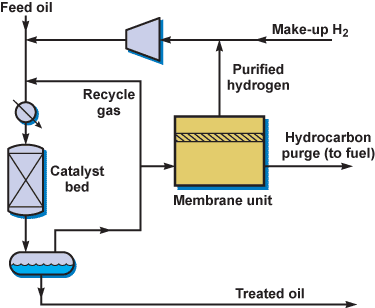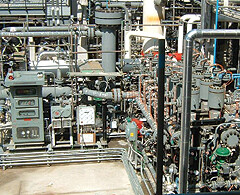Key Publications and Presentations:
Membranes are the simplest, most reliable, and economic method for recovery of hydrogen from refinery streams.
Opportunity
Refinery hydrogen requirements are growing due to the increased use of hydrocracking and hydro-treating, including processes such as HydroFlex™ and VeganR that produces renewable diesel. Residual gas from these processes contains a significant amount of unused hydrogen at pressure, and membranes provide an economical recovery method. MTR’s hydrogen-permeable VaporSep-H2™ membranes can provide 90% to 99% pure hydrogen and greater than 90% recovery.
VaporSep-H2™ Solution

VaporSep-H2™ offers a simple method for recovering hydrogen from refinery streams. Hydrogen permeates preferentially through the membrane, producing a purified hydrogen “permeate” stream and a hydrocarbon-enriched “residue” stream. The available pressure for the purified hydrogen depends on the feed conditions, but can be as high as 1500 psi. The hydrocarbon-enriched “residue” is recovered at close to the feed pressure, and can be sent to directly to fuel, or first treated for liquefied petroleum gas (LPG) recovery if these components have value.
Benefits
- Efficient and economical hydrogen recovery: typically 80% to 98% recovery of feed H2 with a purity of 90 vol% to 99 vol%
- Handles high feed pressures up to 2500 psia
- Reduce flaring and correct refinery fuel balance
- Proven performance, long membrane life, many references

This VaporSep-H2™ unit recovers hydrogen from hydrotreater offgas in an Asian refinery
System Performance
- Feed pressure: up to 2500 psi
- Feed: 1 to 200 MMscfd; 30% to 95 vol% H2
- H2 recovery: greater than 70% to 95+%
- Recovered H2 purity: 95% to 99 vol%
System Description
- Complete skid-mounted unit includes all necessary instrumentation and controls
- Typical size: 20 ft (L) x 8 ft (W) x 18 ft (H); 15,000 lb
Application Areas
- Renewable diesel hydrotreater purges
- Refinery fuel/flare gas
- Hydrodesulphurization purges
- Hydrocracker purges
- Catalytic reformer net gas
- Pressure swing adsorption (PSA) tail gas
- Fluidized catalytically cracked (FCC) overhead gas